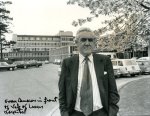
Stanford University (1969-1972)
1969
Although the chemistry department at Stanford is crowded, Pauling gets a laboratory for his work on schizophrenia. Arthur Robinson, his collaborator in San Diego, also moves to Palo Alto to assist Pauling in the running of the laboratory. Despite his university appointments, he continues to be on a leave of absence from the Center for the Study of Democratic Institutions.
In August, a month after United States astronauts have landed on the moon, Pauling, at an international conference at the State University of New York in Stony-brook, criticizes the American space program, stating that it is an indication of the country’s wrong system of values. For example, the United States is spending fifty times more on space than it does on medical research.
1970
Pauling publishes "Evolution and the Need for Ascorbic Acid" in PNAS.
He is awarded the International Lenin Peace Prize for 1968-1969 in June at the Soviet Embassy in Washington, D.C.
Toward the end of the year, he publishes Vitamin C and the Common Cold. The book becomes a best seller, is translated into several foreign languages, and becomes one of his most cited works (it will win the Phi Beta Kappa Book Award in 1971 as one of the most distinguished and important works published in 1970.)
1971
Robert B. Corey dies on April 23 in Pasadena. Pauling participates in the memorial service on the CIT campus on May 5.
In November, Dr. Ewan Cameron, chief surgeon at the Vale of Leven District General Hospital at Lomondside, Scotland, notifies Pauling about his work on cancer patients. He has begun administering vitamin C to terminally-ill cancer patients with positive results. On December 14, Pauling replies to Cameron’s letter, stating that he feels strongly that ascorbic acid may be of great value in the prevention and treatment of cancer. This correspondence marks the start of Pauling’s fruitful collaboration with Dr. Cameron.
1972
In the spring, Ewan Cameron and Linus Pauling submit a paper, "Ascorbic Acid and the Glycosaminoglycans: An Orthomolecular Approach to the Treatment of Cancer and Other Diseases," to PNAS. At a meeting of the Editorial Board of the Proceedings on April 23, the decision is reached that "advocacy of therapeutic procedures" is "out of place" in the Proceedings of the National Academy of Sciences. About May 1, Pauling receives a letter from John Edsall, the Chairman of the Editorial Board, informing him that his and Cameron’s paper is not being accepted for publication. Since Pauling is a distinguished member of the National Academy and since it is practically unheard of for a member’s paper to be refused, he resubmits the paper and the controversy becomes public. The affair raises the question about whether National Academy members have the right to publish what they wish in PNAS. As Pauling points out, traditional policies of the Editorial Board have tended to support this view. Under its new chairman, Robert L. Sinsheimer, the Editorial Board again refuses the Pauling-and-Cameron paper, and the Council of the Academy, at its meeting on August 15, affirms the decision of the Editorial Board. Pauling and Cameron eventually publish their paper in another journal.
On May 10, Pauling writes to Professor William F. Miller, Vice President-Provost of Stanford University, asking that consideration be given to the construction of a laboratory building, adjacent to the Stauffer Chemical Laboratories, to be the site of Pauling’s work then being carried on in a laboratory on the first floor of the Chemical Engineering Building. Pauling has hopes of obtaining a gift of $50,000 to cover half the cost of the building. When his attempts to get Stanford University to put up this temporary wooden building are unsuccessful and when he is unable to resolve the problem of laboratory space for his people through Stanford officials, Pauling decides to move off campus.
In July, Ava Helen Pauling has a cataract removed from her left eye and spends six days in the hospital (two years before, she had the operation on the right eye). She recovers well and is pleased to have binocular vision again.
Arthur Robinson finds a two-story building in Menlo Park, near the Stanford Linear Accelerator. Pauling decides to rent space in this building for himself and his laboratory workers. They plan to move in January.
Table of Contents
- The Ancestry of Linus Pauling (The Paulings)
- The Ancestry of Linus Pauling (The Darlings)
- Linus Pauling's Childhood (1901-1910)
- Linus Pauling's Adolescence (1910-1917)
- Pauling's Years as an Undergraduate at Oregon Agricultural College, Part 1 (1917-1919)
- Pauling's Years as an Undergraduate at Oregon Agricultural College, Part 2 (1919-1922)
- Linus Pauling as a Graduate and Postdoctoral Student at the California Institute of Technology, Part 1 (1922-1923)
- Linus Pauling as a Graduate and Postdoctoral Student at the California Institute of Technology, Part 2 (1924-1926)
- A Guggenheim Fellow in Europe during the Golden Years of Physics (1926-1927)
- Early Career at the California Institute of Technology (1927-1930)
- Pauling's Great Years of Achievement in Structural Chemistry, Part 1 (1931-1932)
- Pauling's Great Years of Achievement in Structural Chemistry, Part 2 (1933-1935)
- Pauling's Increasing Involvement in Molecular Biology (1936-1939)
- The War Years, Part 1 (1940-1942)
- The War Years, Part 2 (1943-1945)
- The Postwar Years, Part 1 (1946-1947)
- The Postwar Years, Part 2 (1948-1949)
- Proteins, Passports, and the Prize (1950-1954)
- Increasing Involvement in World Peace, Part 1 (1955-1958)
- Increasing Involvement in World Peace, Part 2 (1959-1963)
- The Center for the Study of Democratic Institutions (1964-1967)
- The University of California, San Diego (1968-1969)
- Stanford University (1969-1972)
- An Institute for Science and Orthomolecular Medicine, Part 1 (1973-1977)
- An Institute for Science and Orthomolecular Medicine, Part 2 (1978-1981)
- The Years Alone: Pauling after the Death of Ava Helen, Part 1 (1982-1988)
- The Years Alone: Pauling after the Death of Ava Helen, Part 2 (1989-1994)
- About the Author



